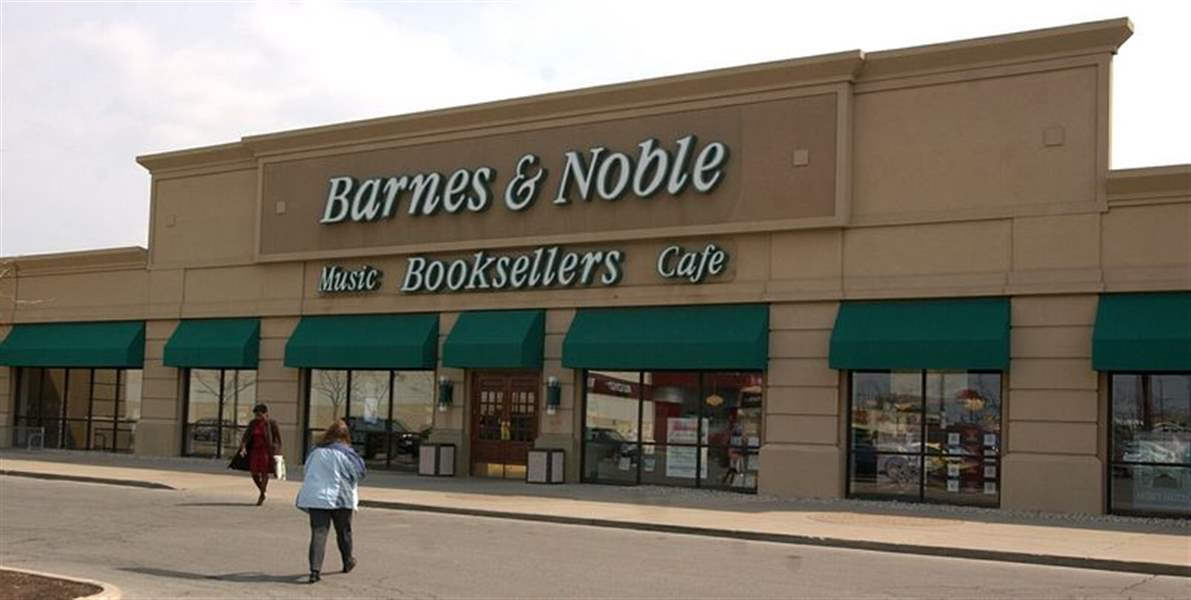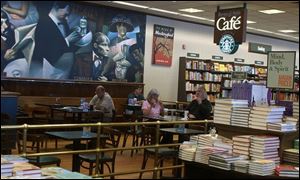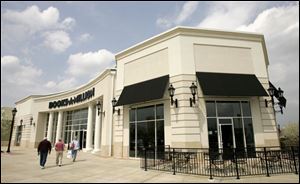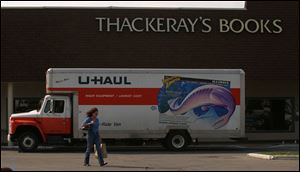
Area book battle goes heavyweight
4/24/2005
Barnes & Noble, on Monroe Street across from Franklin Park, will compete with Borders beginning next week.
king / blade

The chains have copied the cafes and reading nooks made popular by independent stores.
TOYS, electronics, groceries, home improvement, music, sporting goods, drugstores, crafts, pet supplies.
Over the last 20 years, big box retailers in all of these retail niches have rolled into the Toledo area, fighting for market share.
The latest battleground: books.

Books-A-Million, in Perrysburg's Levis Commons
Last week, former employees of the now-closed Thackeray's Books began stocking shelves at the Borders Books and Music superstore nearing completion in Westfield Shoppingtown Franklin Park in Toledo.
But when that store opens next week, it will be chasing two big chains already here.
Just a few hundred feet from the mall on Monroe Street is Barnes & Noble, which has been building a customer base in Toledo for 11 years now. And in February, the Books-A-Million chain began pursuing customers by opening a superstore in Perrysburg's Town Center at Levis Commons.
"The main battle will between Borders and Barnes & Noble because they're so close," said Clyde Dilley, the principal co-owner of Thackeray's, which closed April 12, mainly in anticipation of competition from Borders.
"Books-A-Million can probably get a niche because they're on the other side of the river and it will draw from a different area.

Barnes & Noble, on Monroe Street across from Franklin Park, will compete with Borders beginning next week.
"Borders is going to give Barnes & Noble a lot of competition just because it's newer and prettier, but my big concern about having three big stores like these is: How much of a market is there for them?"
That question is one that the chains, analysts, and a host of other area vendors that sell books - such as Media Play, Target, Kmart, Wal-Mart, and Kroger - most likely are asking.
"My expectation is once Borders is open they'll wait and see what their sales are and that will determine whether they do more stores in the market," said retail specialist Pete Shawaker, a partner at Michael Realty Co., a commercial real estate firm in Toledo.
The only reason any of the three might build more stores locally, he said, is that it thinks it can take sales from a competitor. "If they do, then it's a war," he said.

Borders' entering the Toledo market prompted the closing of Thackeray's, the area's largest independent.
The retreat of Thackeray's, which faced flat sales for years and possible losses with the arrival of Borders, may be a microcosm of the bookstore industry.
"This sort of thing has pretty much happened around the country already," said Avin Mark Domnitz, chief executive of the American Bookseller Association, the main trade group for independent bookstores.
The overall book-selling market nationally is flat, said consultant Barrie Rappaport, of Ipsos-Insight, a research firm specializing in consumer purchasing trends.
Annual growth was 1.3 percent between 1997 and 2002, she said.
Retail sales for bookstores in 2004 were $16.7 billion, or about a 1 percent decline from the year before, according to the U.S. Census Bureau.
Clearly, the large chains have gained at the expense of the independents and smaller chains. Barnes & Noble, for example, sold 9.4 percent of general books sold in 2002, up from 1.9 percent a decade earlier, according to Ipsos-Insight.
Borders' share during that period jumped from 0.5 percent to 4.5 percent, and Books-A-Million went from 0.6 percent to 1.2 percent.
Still, the consultant's research shows that highly educated and high-income households - traditionally the largest buyers of books - have reduced such spending.
That has led the big chains to do battle with each other, sometimes from opposite sides of a street. Barnes & Noble, with 820 stores and an online book business, has $4.9 billion in annual sales. Borders Group Inc., with 1,244 stores, has $3.9 billion.
The chains have copied the cafes and reading nooks popularized by the independents, but wield much more clout with publishers.
Nine years ago, the New York Times detailed how the two chains refined and expanded the process of collecting money from publishers to promote books by selling prime space at the front of stores, on prominent book shelves, in display windows, and on the ends of shelves. Such practices have been common for many years in grocery stores.
Dennis Fennell, owner of Fireside Books in the Toledo suburb of Holland, said he doesn't feel like a target because the big chains "don't really care about the little guys. We aren't a threat."
He is the area's last remaining independent general bookseller, and said he is geographically safe for now because most people won't travel too far to buy a book and the chain stores aren't near him.
Pauline Butz, a Maumee resident who shops at Books-A-Million, is proof of that. She "just loves books" and enjoys the national chain, mainly for its large selection.
Borders and Barnes & Noble sound nice, Mrs. Butz said, "but that's just too far. This is close and that's why I will come here."
The big chains work hard to establish a community identity, to stock desired books, and to sponsor or coordinate programs such as children's events at the public library.
"We constantly review what we do and what we're selling and what people are asking for," said Jennifer Habraych of Barnes & Noble.
Barnes & Noble and Borders approach book selling differently, according to an offshoot of Workforce magazine, which has studied the two chains. The first chain prefers clean-cut employees who can help customers find what they want and check out quickly, while the latter lets workers dress as they like, sport tattoos or earrings, and show their personalities more, Workforce.com said.
Not surprisingly, when Mr. Dilley told executives at Borders - which supplied Thackeray's with books - that his store was closing, Borders moved swiftly to hire nearly all of Thackeray's employees. They were valuable because they might bring along Thackeray's customers and are considered an eclectic bunch with diverse personalities.
Contact Jon Chavez at:
jchavez@theblade.com
or 419-724-6128.